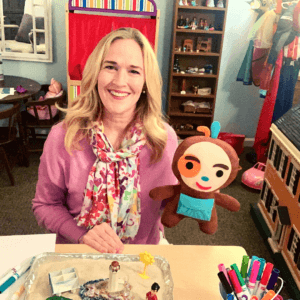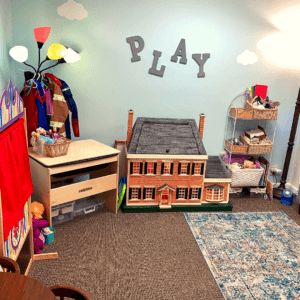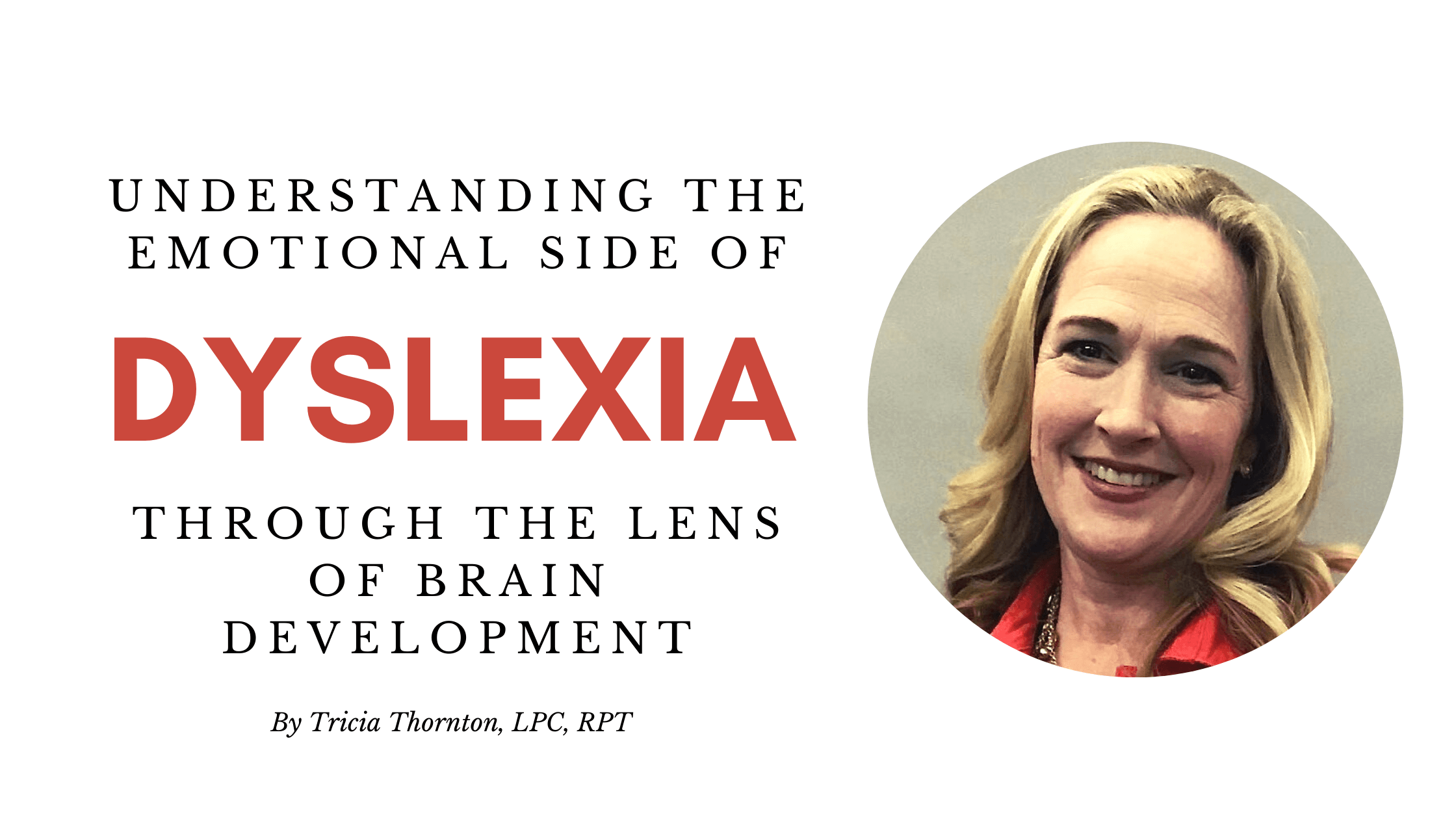Today’s guest blogger is Tricia Thornton of Tricia Thornton Therapy in Nashville, Tennessee.
“Lazy,” “disorganized,” “socially awkward,” “challenging,” “difficulty focusing”…are these words that you have heard to describe your child with dyslexia? Many labels are assigned to a child that has been diagnosed with dyslexia that become hurtful and will produce a variety of dysregulated emotions. How does the brain of a child with dyslexia differ from a child without dyslexia? How are emotions related to these differences? What can I do to help my child feel empowered rather than torn down? When do I need to seek help for my child?
We will start with a brief overview of the differences in the brain structure and functionality. Dyslexia is a neurobiological disorder that effects the makeup of the brain. There are two types of matter in our brains, grey and white. Grey matter is found throughout the brain. It is made up of neuronal cell bodies that are responsible for processing information. White matter is found deep within the brain and is made up of connective tissues called myelin which are designed to transfer information between cells. White matter is responsible for transmitting information within the various regions of the brain. Research has revealed that a dyslexic brain has less of each type of matter. Therefore, there is a deficit processing information in general and a decrease in the ability for the brain to transmit information. Understanding how the brain is structured is key to a child’s and a parent’s ability to manage the emotional effects of the learning disorder. Once a child begins to know that there is a difference in how their brain is structured helps him/her to not turn their negative emotions inward. They begin to feel a relief that they have not been “lazy”, “disorganized”, “strange”, etc. Parents also feel relieved that they have not caused the disorder due to their style of parenting.
What are some of the emotions that a child with dyslexia begins to feel? The most common are anxiety, anger, challenges with their self-image, and sibling rivalry. Out of those, anxiety tends to be the main disruptive emotion. Because of the nature of the disorder and the delays that are caused with processing information, a child with dyslexia receives mixed messages from the outside world. Before the disorder is diagnosed and understood, their teachers and caregivers may think the child is not motivated or argumentative. That negative message then causes the child to feel inadequate and insecure which leads to anxiety.

Anxiety can be masked in 8 ways: anger, chandeliering, difficulty sleeping, lack of focus, negativity, avoidance, defiance, and overplanning. Once a child is labeled as being “slower” or “socially awkward”, then he or she begins to feel negative about their self-image and self-confidence wanes. The child often compares their reading speed/ability to a classmate’s. The child with dyslexia begins to negatively internalize the differences of their ability. Once, they feel “different”, their confidence decreases, and then the anxiety increases. Anger also stems from the frustrations of not being able to recall words quickly or follow a sequence of directions. They become angry at themselves and then project that anger onto their caregivers and siblings. A child will hold in their struggles all day, and then may become angry even full of rage toward their closest caregiver. This poses a struggle for the caregiver, even causing the adult to become angry, too. Sibling rivalry may increase as the attention of the family goes to assisting the child with the learning disability. If the sibling does not have dyslexia, then they may become jealous of the time the caregivers are spending with their brother or sister. This also causes trouble for the dyslexic child leading to feeling guilt and shame.
Emotions like anxiety and anger originate in the limbic region of the brain. Your brain is constantly receiving messages that go into the thalamus. The messages are then routed to either the amygdala or to the prefrontal cortex. Once the messages land into the emotional region of the brain, the brain’s natural responses begin to ignite. The lessened amount of grey and white matter in a dyslexic brain directly effects the processing speed and ability to transmit messages between the amygdala and the cortex. Therefore, a child with dyslexia may have a harder time regulating their emotions. Outbursts of anger, display of anxiety, and the lack of self-confidence may increase.
What can a parent do to help empower a child to use tools to help regulate their emotions? First, a parent and other clinicians can help a child with dyslexia to understand the neurological disorder. In my practice, as a Licensed Professional Counselor and a Registered Play Therapist, I actually use a model of the brain to help the child and parent understand about their emotions. It is quite amazing how the child will light up when they begin to understand that it is their brain’s structure that causes the dyslexia not their behavior or emotions. Second, a parent and other caregivers can use a “whole brain” parenting approach. By first connecting with a child on an emotional level then redirecting them, a child can fill their necessary buckets of getting positive attention and feeling empowered. Third, a child and parent can learn how to use tools to begin to deal with the big feelings that come up during the day.

At Tricia Thornton Therapy, I teach a child about tools to put in their toolbox: the five senses activity, deep breathing and movement, using positive thoughts to replace negative thoughts, and counting to 10. Another resource I provide is recording a weekly live video on Tricia Thornton Therapy’s Facebook page called, “T Cubed Corner”. The videos are geared more for ages 3 years to 12 years and ideally can be watched by the parent and child together. Parent trainings and parent consultations also are helpful for adults to learn how they can assist their child.

A question that I am often asked is “When should I seek out help for my dyslexic child?”
It is helpful to think of the bell curve. If you often see behaviors that tend to be outlying on the curve, then you will begin to notice patterns. When a child is displaying any or several or all of the 8 ways that anxiety is masked, then that is time to think of getting help. If you feel your child is dominating your energy and family, then that is another sign to seek out therapy. Play therapy in particular is effective for children who have dyslexia or other learning disabilities. Play is a child’s language. A play therapist will enter the child’s world by providing a safe place for the child to process their emotions through play. Directive and child-centered approaches can both be used during play therapy. A parent will also want to seek out individual help if they begin to feel that their buttons are often being pushed. Parent-child therapy is effective as well as whole family therapy. Ideally, the therapist will want to involve the school through consultations to create a team approach to working with the child and family.
“Play is a child’s language. A play therapist will enter the child’s world by providing a safe place for the child to process their emotions through play.”
In conclusion, understanding the dyslexic brain empowers a child and parent to appropriately address the dis-regulated emotions. Learning how to use effective tools will help the child and parent to deal with the big feelings that often arise for a child with dyslexia. Seeking out help is a gift to yourself, to your child, and to the whole family.
Tricia Thornton is a Licensed Professional Counselor and Registered Play Therapist. She has experience as a School Counselor K-12 in public and private schools in the Nashville area. Her mission is to develop the heart, mind, and soul of children by empowering them through play.
You can learn more about play therapy at Tricia Thornton Therapy. 
Check out Tricia’s interview at NDC’s YouTube Channel and subscribe!

